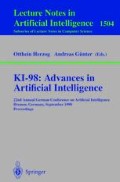Abstract
The control of mobile robots acting autonomously in the real world is one of the long-term goals of the field of artificial intelligence. So far the field lacks methods bridging the gap between the sophisticated symbolic techniques to represent and reason about action and more and more reliable low-level robot control and navigation systems. In this paper we present GOLEX, an execution and monitoring system for the logic-based action language GOLOG and the complex and distributed RHINO control software which operates on RWI B21 and B14 mobile robots. GOLEX provides the following features: it maps abstract primitive actions into low-level commands of the robot control system, thus allowing the user to concentrate on the application rather than the inner workings of the robot; it monitors the execution of the primitive GOLOG actions, making it possible to detect simple execution failures and timeouts; and it includes means to deal with sensing and user input and to continue the operation appropriately. We present two different real-world applications in which GOLEX successfully operated a mobile robot in dynamic and even unstructured environments. These results suggest that the time is ripe for using symbolic action languages for mobile robot applications.
Preview
Unable to display preview. Download preview PDF.
References
M. Beetz and D. McDermott. Improving robot plans during their execution. In Kris Hammond, editor, Second International Conference on AI Planning Systems, pages 3–12, Morgan Kaufmann, 1994.
W. Bibel. Let’s plan it deductively. In Proceedings of the Fifteenth International Joint Conference on Artificial Intelligence, volume 2, pages 1549–1562, August 1997.
J. Buhmann, W. Burgard, A.B. Cremers, D. Fox, T. Hofmann, F. Schneider, J. Strikos, and S. Thrun. The mobile robot RHINO. AI Magazine, 16(2):31–38, Summer 1995.
W. Burgard, Armin B. Cremers, D. Fox, D. Hähnel, G. Lakemeyer, D. Schulz, W. Steiner, and S. Thrun. The interactive museum tour-guide robot. In Proc. of the Sixteenth National Conference on Artificial Intelligence (AAAI-98), 1998. To appear.
W. Burgard, D. Fox, D. Hennig, and T. Schmidt. Estimating the absolute position of a mobile robot using position probability grids. In Proc. of the Fourteenth National Conference on Artificial Intelligence, pages 896–901, 1996.
J. G. Carbonell, C. A. Knoblock, and S. Minton. Prodigy: An integrated architecture for planning and learning. In K. Van Lehn, editor, Architectures for Intelligence. Erlbaum, 1990.
C. Fedor. TCX. An interprocess communication system for building robotic architectures. Programmer’s guide to version 10.xx Carnegie Mellon University, Pittsburgh, PA 15213, 12 1993.
D. Fox, W. Burgard, and S. Thrun. The dynamic window approach to collision avoidance. IEEE Robotics and Automation Magazine, 1997.
G. de Giacamo, Y. Lespérance, and H. J. Levesque. Reasoning about concurrent execution, prioritized interrupts, and exogenous actions in the situation calculus. In Proceedings of the Fifteenth International Joint Conference on Artificial Intelligence, volume 2, pages 1221–1226, 1997.
G. de Giacomo and H. J. Levesque. An incremental interpreter for high-level programs with sensing. Technical report, University of Toronto, 1998.
G. de Giacomo, R. Reiter, and M. M. Soutchanski. Execution monitoring of high-level robot programs. In Proceedings of the Sixth International Conference on Knowledge Representation (KR 98), 1998. To appear.
K. Z. Haigh and M. M. Veloso. High-level planning and low-level execution: towards a complete robotic agent. In Proceedings of the First International Conference on Autonomous Agents, Marina del Rey, CA, February 1997.
K. Konolige. Colbert: A language for reactive control in saphira. In KI-97: Advances in Artificial Intelligence, pages 31–52. LNAI Series, Springer Verlag, 1997.
G. Lakemeyer. On sensing and off-line interpreting in golog. Technical report, RWTH Aachen, 1998.
H.J. Levesque, R. Reiter, Y. Lespérance, F. Lin, and R. Scherl. GOLOG: A logic programming language for dynamic domains. Journal of Logic Programming, 31:59–84, 1997.
F. Lin and R. Reiter. State constraints revisited. Journal of Logic and Computation, special issue on actions and processes, 4:665–678, 1994.
J. McCarthy. Situations, actions and causal laws. In Semantic Information Processing, pages 410–417. MIT Press, 1968.
Nils J. Nilsson. SHAKEY the robot. Technical report, SRI International, 1984.
R. Reiter. The frame problem in the situation calculus: A simple solution (sometimes) and a completeness result for goal regression. In V. Lifshitz, editor, Artificial Intelligence and Mathematical Theory of Computation, pages 359–380. Academic Press, 1991.
R. Reiter. Sequential, temporal golog. In Proceedings of the Sixth International Conference on Knowledge Representation (KR 98), 1998. To appear.
S. Thrun, A. Bücken, W. Burgard, D. Fox, T. Fröhlinghaus, D. Hennig, T. Hofmann, M. Krell, and T. Schimdt. Map learning and high-speed navigation in RHINO. In D. Kortenkamp, R.P. Bonasso, and R. Murphy editors, AI-based Mobile Robots: Case studies of successful robot systems. MIT Press, Cambridge, MA, 1998.
Author information
Authors and Affiliations
Editor information
Rights and permissions
Copyright information
© 1998 Springer-Verlag Berlin Heidelberg
About this paper
Cite this paper
Hähnel, D., Burgard, W., Lakemeyer, G. (1998). GOLEX—Bridging the Gap between Logic (GOLOG) and a real robot. In: Herzog, O., Günter, A. (eds) KI-98: Advances in Artificial Intelligence. KI 1998. Lecture Notes in Computer Science, vol 1504. Springer, Berlin, Heidelberg . https://doi.org/10.1007/BFb0095437
Download citation
DOI: https://doi.org/10.1007/BFb0095437
Published:
Publisher Name: Springer, Berlin, Heidelberg
Print ISBN: 978-3-540-65080-5
Online ISBN: 978-3-540-49656-4
eBook Packages: Springer Book Archive

